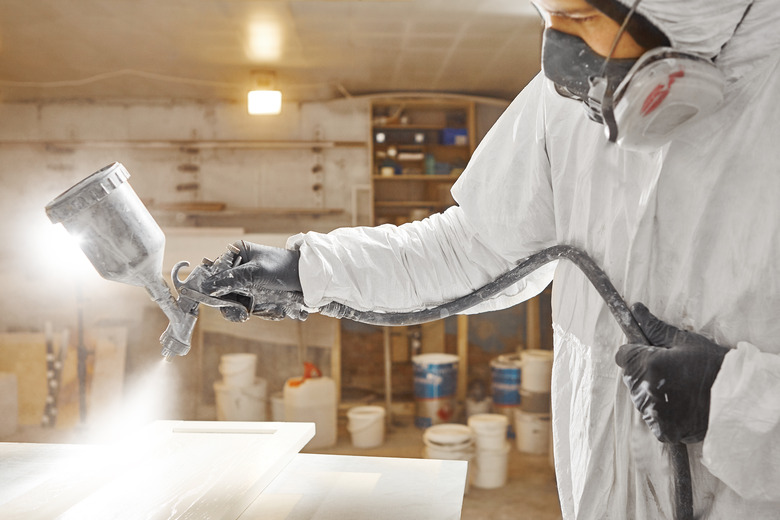What Are The Differences Between Airless And Air Sprayers?
We may receive a commission on purchases made from links.
The main difference between an air sprayer and an airless sprayer is right there in the names: An air sprayer creates a spray by mixing finishing materials with a stream of compressed air, while an airless sprayer does the job not with air but with a pump. As far as the painter is concerned, the main difference is the quality of the spray and the final finish, but there are others as well, including types of materials you can spray and the type of equipment you need.
Because it needs pressurized air, an air sprayer has traditionally been used in conjunction with a compressor, a fairly bulky piece of auxiliary equipment that has to stay connected to the gun by hoses that get in the way. If manufacturers can fit a compressor powerful enough to pump up a car tire into a housing the size of a jewelry box, you might wonder if they could do the same for air sprayers. Well, they have, so that eliminates one of the main disadvantages of air sprayers, but they still aren't the best choice for every job.
How Paint Sprayers Work
How Paint Sprayers Work
The first paint sprayer, invented by Joseph Binks in 1887, was something of an amalgam between air and airless sprayers because it worked by pressurizing a paint container manually to force material through the tip of a spray gun. This "pressure pot" system is still around, although pressure is usually supplied by a compressor, not by hand. More common are two other systems that mix air and finish material directly at the nozzle to produce an atomized spray: gravity-fed (the cup attaches above the nozzle) and siphon (the cup is below the nozzle). In all of these systems, the mixture of air and material produces a very fine spray.
The Gray Company, now known as Graco, invented the first airless sprayer in 1958. The general idea, which is the one employed today by other manufacturers as well as Graco, is to use a hydraulic pump to turn finishing material into a spray by forcing it through a small aperture. It takes much more pressure to atomize paint in this way, and the spray pattern tends to be grainier, but an airless sprayer delivers a much higher volume of material per unit time than an air sprayer.
Spray Quality Matters
Spray Quality Matters
In a nutshell, an air sprayer is best for decorative finishes, while an airless sprayer is best suited for protective finishes. You would apply a decorative finish to cabinets, interior furnishings, automobiles, and some outdoor furnishings. Walls, fences, and other large surfaces, on the other hand, call for a high volume of material to form a protective coating, and the quality of the final finish isn't as important. One of the advantages of airless sprayers is that they can spray high-viscosity material without the need for thinning; you almost always have to thin material before spraying it with an air gun.
Because the spray from an air sprayer is delicate, it leaves a thin coating on the surface that usually has to be built up by repeated applications. That provides the opportunity to buff between coats to produce the highest-quality finish possible. The high volume of material an airless sprayer delivers is more difficult to control, but it allows you to cover a large surface in a fraction of the time it would take to do it with an air sprayer.
Should You Choose an Air Sprayer or Airless Sprayer?
Should You Choose an Air Sprayer or Airless Sprayer?
In the not-too-distant past, both air and airless spray guns had to be connected to remote equipment by hoses. In the case of an air sprayer, it was a compressor, and for an airless sprayer, it was a large pump that sucked paint directly out of a bucket. These days, both air sprayers and airless sprayers are available as corded or cordless handheld tools that are equally easy to use, so the choice between one or the other isn't as clear cut as it used to be.
One way to decide is by the viscosity of the product you're spraying. Airless sprayers can handle paint and varnish that hasn't been thinned, while air sprayers generally can't. Another factor is the quality of finish you're after. Air sprayers do a better job on cabinets and furniture. A third consideration is the size of the job. Airless sprayers pump more material and will do walls, fences, decks, and other large surfaces much faster than air sprayers while wasting less material as overspray.
